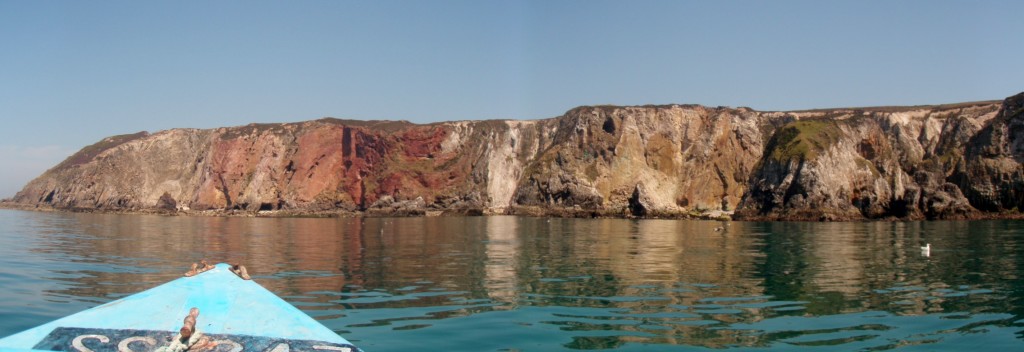Beth is a PhD student at the Camborne School of Mines, University of Exeter. You can follow her on twitter @thegeogirl.
In a PhD office of people studying rocks in Liberia, Senegal, South Africa and Brazil, my study, centering on the so-called “critical metals” (Li, Be, Nb, Ta, In, Sb, Sn, W and Bi) in the granites southwest England, the place where I was born and raised, seemed highly unadventurous and not at all exotic. However, some of the granite exposures are spectacular, from rugged moorlands to dramatic coastal exposures, and I will describe two of my favourites here.

Varied exposures of the Cornubian Batholith. Clockwise from top left: Granite boulders on the Isles of Scilly beaches; A disused china clay pit, St. Austell Granite; The iconic Towanroath engine house, near St. Agnes; Moorland exposure at Hound Tor, Dartmoor Granite.
The Cornubian Batholith is an ENE-WSW-trending composite granite spine extending over 200 km from the Dartmoor Granite in the east to the Isles of Scilly Granite in the west. The granites intruded from ~298-270 Ma into Devonian and Carboniferous metasedimentary rocks, at the end of the Variscan Orogeny, when the region was undergoing a period of tectonic extension and the granites are accompanied by coeval lamprophyres and basalts. Felsic rocks associated with the batholith include rhyolite and microgranite sheets, quartz porphyry dykes (known as elvans), aplites, topaz aplites, pegmatites and a range of granite types, from coarse- to fine-grained with variable sizes and abundances of alkali feldspar phenocrysts (e.g. Dangerfield and Hawkes, 1981).
Southwest England is perhaps most well-known for its extensive mining, with iconic engine houses littering the landscape, now protected by World Heritage status. Much of the mineralisation is granite-derived, with synbatholith polymetallic “lode” systems formed during variable mixing of magmatic, meteoric and metamorphic fluids (Jackson et al., 1989). China clay extraction continues in the St. Austell Granite in the centre of Cornwall.
Cligga Head, located in between the towns of St. Agnes and Perranporth on the north coast of Cornwall is a classic locality to see an endogranitic greisen-bordered sheeted vein complex and elvans. The view of the sheeted vein system on land is pretty good, but nothing beats the view from a boat. Closely spaced quartz + tourmaline greisen bordered (muscovite-quartz-topaz) veins up to 0.2 m wide extend the entire cliff profile making a dramatic view from the bottom of the cliffs. These quartz-tourmaline veins carry the primary ore minerals wolframite and cassiterite, with minor stannite. The vein system is exploited by later sulphide-bearing mineral veins containing quartz-chlorite-pyrite-chalcopyrite-arsenopyrite-pyrite assemblage. The granite hosting the greisen is a minor pluton, extending no more than 600 m and is coarse-grained with alkali feldspar phenocrysts, lithium-rich biotite micas, plagioclase (almost pure albite), muscovite, topaz and minor tourmaline.

View of Cligga Head from a boat. The granite outcrops to the north (left), with the sheeted Sn-W and polymetallic sulphide veins towards the centre (red) and the country rock and elvans to the south (right).
Towards the east, the old mine buildings remain overlooking the stretch of coast from Perranporth to Penhale Corner. The mine was worked for tungsten until the late 1940s with buddles (gravity separation) used for concentrating the ore. Remains of the old truck lines can be seen in the coastal exposures. The bay which Cligga overlooks, Hannover Cove, is named for “the richest wreck in British waters”, the packet ship Hannover. Wrecked in the 17th Century, the ship was apparently laden with gold. Attempts to salvage this gold in the 1990s didn’t lead to riches and glory, but did uncover several cannons, one of which ended up on Ebay in 2014.
Priests Cove and Porth Ledden, also on the north coast of Cornwall, but further west, lie within a major pluton, the Land’s End Granite. Both have exposures of typical Land’s End Granite, a coarse-grained biotite-rich porphyritic variant, with alkali feldspar phenocrysts up to 100 mm long. The contact between the granite and cordierite-spotted hornfelsed metasedimentary rocks is well exposed at Priests cove beneath the fishermans’ huts. Granite sheets and veins crosscut the metasedimentary rocks nearby, with pegmatitic borders on the contacts. Locally, the granite contains pegmatitic quartz-tourmaline pockets.
At Porth Ledden, walking from west to east, you cross hornfelsed metasedimentary rocks, coarse-grained porphyritic granite into quartz-tourmaline rock before reverting back to the granite again. At this locality, the granite is highly variable containing mafic microgranular enclaves with feldspars protruding into the enclosing granite, metasedimentary enclaves, fine-grained granite, quartz-tourmaline rock and quartz-tourmaline veins. For true variety of the Cornubian Batholith, walk the 350 m across Porth Ledden!

Quartz-tourmaline vein and fine-grained granite cross-cutting a coarse-grained porphyritic granite containing mafic and metasedimentary enclaves. Or…the Cornish flag.
References
Dangerfield, J. & Hawkes, J. R. 1981. The Variscan granites of south-west England: additional information. Proceedings of the Ussher Society, 5, 116-120
Willis-Richards, J. & Jackson, N. J. 1989. Evolution of the Cornubian ore field, southwest England: Part I. Batholith modeling and ore distribution. Economic Geology, 84, 1078-1100
![]() This work is licensed under a Creative Commons Attribution-NonCommercial-ShareAlike 4.0 International License.
This work is licensed under a Creative Commons Attribution-NonCommercial-ShareAlike 4.0 International License.







